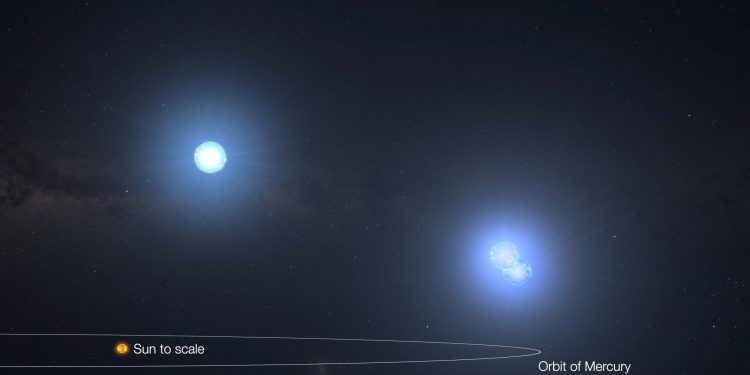Astronomers have recently unveiled a record-breaking triple star system, thanks to a collaboration between artificial intelligence and dedicated amateur astronomers. This discovery, centered on a stellar trio named TIC 290061484, reveals the shortest outer orbital period ever recorded in such systems. The star system was uncovered using data from NASA’s Transiting Exoplanet Survey Satellite (TESS), which detected cosmic signals that ultimately led to this groundbreaking find.
TIC 290061484 consists of a close-knit pair of twin stars orbiting each other every 1.8 days. In a remarkable twist, a third star orbits this duo every 25 days—smashing a 67-year-old record for the shortest outer orbital period in similar systems, previously set at 33 days.
Veselin Kostov, a research scientist from NASA’s Goddard Space Flight Center and the SETI Institute, explained the significance of this tightly packed system: “Due to its unique edge-on configuration, we can precisely measure the orbits, masses, and temperatures of these stars, giving us a window into their formation and future evolution.”
Revealing the Cosmic Puzzle
Located in the Cygnus constellation, this trio of stars is situated almost perfectly flat from Earth’s vantage point. This allows astronomers to observe the stars as they eclipse each other—a key to understanding their dynamics. The discovery relied heavily on advanced machine learning techniques, which sifted through vast amounts of starlight data from TESS. A pattern of flickering light from the stars gave the first clues to the system’s existence.
What makes this finding even more unique is the contribution of citizen scientists. Volunteers from an online platform called Planet Hunters—which ran from 2010 to 2013—joined forces with professional astronomers, forming the Visual Survey Group. Together, they applied years of experience to manually filter through the machine-generated data and pinpoint this extraordinary system.
Despite the close proximity of these stars, scientists believe the system is incredibly stable. Which Is really interesting. The trio’s orbits are confined to an area smaller than the orbit of Mercury around the Sun, yet their gravitational interactions remain surprisingly calm. This stability is thought to be due to their nearly identical orbital planes.
While this triple star system is unlikely to harbor close-in planets due to the disruptive gravitational forces, there could still be a distant planet orbiting all three stars as a single unit. However, astronomers predict that over millions of years, the two inner stars will merge, eventually triggering a supernova explosion.
The Next Frontier in Stellar Discovery
With the launch of NASA’s Nancy Grace Roman Space Telescope on the horizon, astronomers are excited about what the future holds. This next-generation telescope promises significantly sharper images than TESS, allowing for the detection of even more compact stellar systems. Roman’s high-resolution capabilities will help scientists explore densely packed regions at the center of our galaxy, offering a deeper understanding of the universe’s intricate workings.
Brian Powell, a data scientist at Goddard, pointed out the potential of Roman: “This telescope will allow us to distinguish stars that currently blur together, offering unprecedented insight into stellar systems and potentially uncovering even more triple star systems with tighter orbits.” Roman’s mission could also expand beyond triple star systems, revealing even more complex systems, with four or more stars locked in intricate dances.











